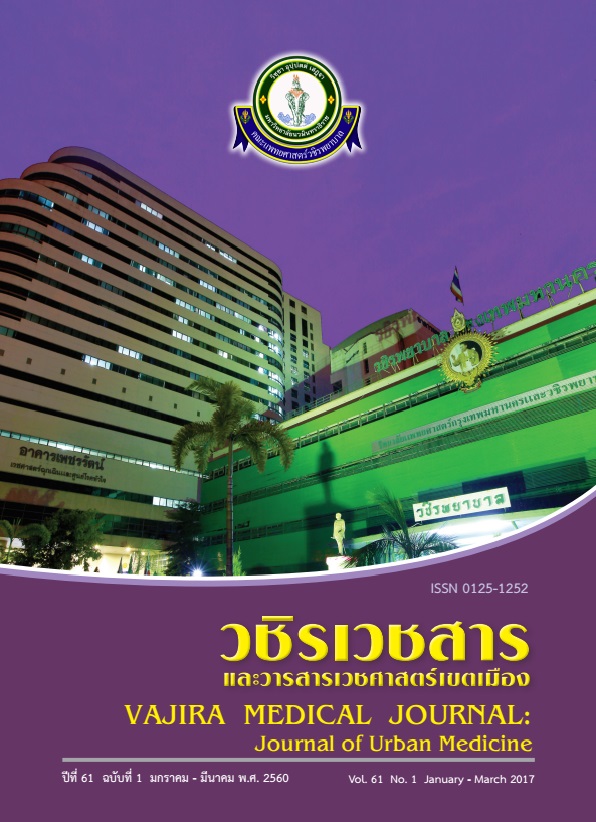Estrogen, Progesterone and Her-2 Receptors Status in Breast Cancer Patients
Main Article Content
Abstract
Objective: To study the estrogen receptor (ER), progesterone receptor (PR) and Her-2 Receptor status in breast cancer patients.
Methods: Retrospective descriptive study. A total of 437 patients with breast cancer treated in Radiation Oncology Division, Faculty of Medicine Vajira hospital between 1996-2009 were enrolled. Clinical and histological data were assessed from medical records and pathological reports. The results were reported as the expression of Estrogen, Progesterone and Her-2 Receptors status and the factors affecting the expression of all receptors were analyzed.
Results: The ER, PR and HER2 were positive in 56.10%, 53.24% and 33.52%, respectively. The proportion of ER+PR+, ER+PR-, ER-PR+, ER-PR- were 46.98 %, 9.56%, 5.46% and 37.2%. Her-2 showed highest positive frequency (17.82%) when both ER and PR were negative. Her-2 showed highest negative frequency (41.37%) when both ER and PR were positive. ER and PR overexpression were associated significantly with lower histological grade (p=0.04 and 0.01). Her-2 overexpression was significantly associated with higher histological grade (p<0.001)
Conclusion: ER and PR positive is the most common status. We found the relationship between the expression of ER, PR and Her-2 receptor status. ER, PR and Her-2 overexpression were associated with histological grade.
Downloads
Article Details
References
2. Siegel RL, Miller KD, Jemal A. Cancer statistics 2016 CA Cancer J Clin. 2016; 66:7-30.
3. Imsamran W, Chaiwerawattana A, Wiangnon S, Pongnikorn D, Suwanrungrung K, Sangrajang S et al. Martin N, Cheirsilpa A. Cancer in Thailand 2010-2012. Bangkok: National Cancer Institute 2015; 44p.
4. Goldhirsch A, Wood WC, Gelber RD,Coates AS, Thurlimann B, Senn HJ. Meeting highlights: updated international expert consensus on the primary therapy of early breast cancer. J Clin Oncol. 2003; 21:3357-65.
5. Colleoni M, Gelber S, Coates AS. Influence of endocrine-related factors on response to perioperative chemotherapy for patients with node negative breast cancer. J Clin Oncol. 2001; 19:4141-9.
6. Hayes DF. Markers of increased risk for failure of adjuvant therapies. The breast 2003; 12 (suppl.1): S14.
7. Allred DC, Harvey JM, Berardo M. Prognostic and predictive factors in breast cancer by immunohistochemical analysis. Mod Pathol. 1998; 11:155-68.
8. Gusterson BA, Gelber RD, Goldhirsch A. Prognostic importance of c-erbB-2 expression in breast cancer. J Clin Oncol. 1992; 10: 1049-56.
9. Hanna W, Kahn HJ, Trudeau M. Evaluation of Her-2/neu (erbB-2) status in breast cancer: from bench to bedside. Mod Pathol. 1999; 12: 827-34.
10. Fisher B, Wickerham DL, Redmond C. Recent developments in the use of systemic adjuvant therapy for the treatment of breast cancer. Semin Oncol. 1992; 19: 263-77.
11. Tamoxifen for early breast cancer: an overview of the randomized trials. Lancet. 1998; 351:1451-71.
12. Osborne CK, Bardou V, Hopp TA. Role of the estrogen receptor coactivator AIBI (SRC-3) and HER-2/neu in tamoxifen resistance in breast cancer. J Natl Cancer Inst. 2003; 95:353-61.
13. Stierer M, Rosen H, Weber R. Comparison of immunohistochemical and biochemical measurement of steroid receptors in primary breast cancer: Evaluation of discordant findings. Breast Cancer Res Treat. 1998; 50:125-34.
14. Hawkins RA. Receptors in the management of breast cancer. Br J Hosp Med. 1985; 34: 160-4.
15. Brooks SC, Saunders DE, Singhakowinta A. Relation of tumor content of estrogen and progesterone receptors with response of patient to endocrine therapy. Cancer. 1980; 46: 2775-8.
16. Slamon DJ, Godolphin W, Jones LA. Studies of the HER-2/neu proto-oncogene in human breast and ovarian cancer. Science. 1989; 244:707-12.
17. Revillion F, Bonneterre J, Peyrat JP. ERBB2 oncogene in human breast cancer and its clinical significance. Eur J Cancer. 1998; 34:791-808.
18. Pauletti G, Godolphin W, Press MF. Detection and quantitation of HER-2/neu gene amplification in human breast cancer archival material using fluorescence in situ hybridization. Oncogene. 1996; 13: 63-72.
19. Muss HB, Thor AD, Berry DA. C-erbB-2 expression and response to adjuvant therapy in women with node-positive early breast cancer. N Engl J Med. 1994; 330:1260-6.
20. Hortobagyi GN. Overview of treatment results with trastuzumab (Herceptin) in metastatic breast cancer. Semin Oncol. 2001; 28:43-7.
21. McKeage K, Perry CM. Trastuzumab: a review of its use in the treatment of metastatic breast cancer overexpressing HER2. Drugs. 2002; 62: 209-43.
22. Ligibel JA, Winer EP. Trastuzumab/chemotherapy combinations in metastatic breast cancer. Semin Oncol. 2002; 29: 38-43.
23. Slamon DJ, Leyland-Jones B, Shak S. Use of chemotherapy plus a monoclonal antibody against HER2 for metastatic breast cancer that overexpresses HER2. N Engl J Med. 2001; 344:783-92.
24. Norton L, Slamon D, Leyland-Jones B. Overall survival advantage to simultaneous chemotherapy plus the humanized anti - HER2 monoclonal antibody Herceptin in HER2 - overexpressing metastatic breast cancer. Proc Am Soc Clin Oncol. 1999; 18:127a (abstr).
25. Elledge RM, Clark GM, Chamness GC. Tumor biologic factors and breast cancer prognosis among white, Hispanic and black women in the United States. J Natl Cancer Inst. 1994; 86: 705-12.
26. Tavassoli FA, Devilee P, Eds: World Health Organization Classification of Tumours. Pathology and Genetics of Tumours of the Breast and Female Genital Organs Lyon: IARC Press; 2004.
27. Lertsanguansinchai P, Chottetanaprasith T, Chatamra K. J Med Assoc Thai. 2002; 85 (Suppl 1): S193-202.
28. Varshney D, Zhou YY, Geller SA, Alsabeh R: Determination of HER-2 status and chromosome 17 polysomy in breast carcinomas comparing HercepTest and PathVysion FISH assay. Am J Clin Pathol. 2004; 121: 70-7.
29. Ashba J, Traish AM: Estrogen and progesterone receptor concentrations and prevalence of tumor hormonal phenotypes in older breast cancer patients. Cancer Detect Prev. 1999; 23: 238-44.
30. Taucher S, Rudas M, Mader RM, Gnant M, Dubsky P, Bachleitner T,et al: Do we need HER- 2/neu testing for all patients with primary breast carcinoma? Cancer. 2003; 98: 2547-53.


